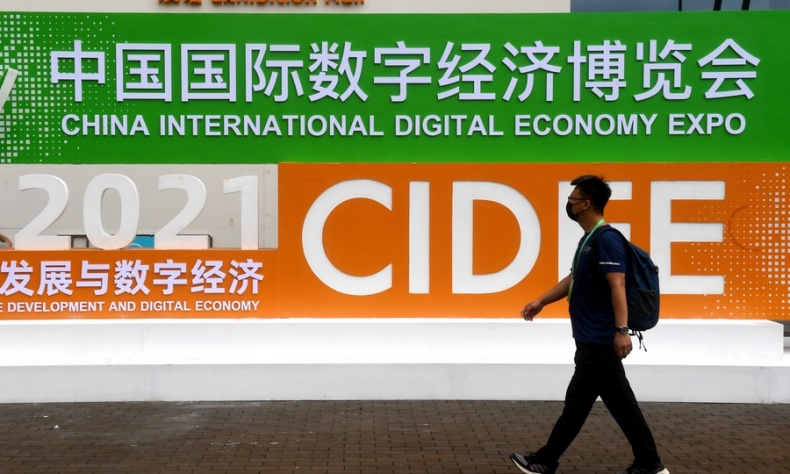A New Economic Model Gains Prominence in the Information Age

It is necessary for the government to provide support for increased input in research and development as well as technology demonstrations. While lending its hand, the government must avoid overstretching itself to the detriment of the industry.
The digital economy, a model that has emerged following the agricultural and industrial economies, has been thriving. In China, its added value increased from 2.6 trillion yuan ($410.09 billion) in 2005 to 39.2 trillion yuan ($6.18 trillion) in 2020, said a white paper published by a think tank affiliated with the Ministry of Industry and Information Technology.
According to the plan on its development during the 14th Five-Year Plan (2021-25) period issued by the State Council in December 2021, the added value of the sector’s core industries will account for 10 percent of China’s GDP by 2025, up from 7.8 percent in 2020. These industries include digital product manufacturing and services, technology application and Internet-based businesses.
Core technologies
Promoting the digital economy is a choice of strategic significance to seize the opportunities arising from the new round of scientific and industrial revolution, said Chinese President Xi Jinping in a recent article published in Qiushi Journal, an official publication of the Communist Party of China Central Committee. According to him, its sound growth is conducive to fostering a new development paradigm, promoting the creation of a modern economy and building up the country’s competitive advantages.
In his article, Xi stressed making breakthroughs in core technologies in key fields, accelerating new infrastructure development, improving the digital economy governance and participating in international cooperation.
Gao Dan, Business Director of CCID Consulting, told CBNweekly that for the sake of maintaining sustainable development, the key to energizing the digital economy lies in creating breakthroughs in core technologies, which concerns not only the industry’s long-term development, but also the upgrading of China’s industrial and supply chains. These technologies include big data, cloud computing and artificial intelligence.
In Gao’s view, China faces both opportunities and challenges. From the former perspective, the country’s information technology (IT) industry, after many years of expansion, has remarkably improved in overall competitiveness, and the digital era is restructuring the traditional IT industry, providing newfangled opportunities. From the latter perspective, China today faces uncertainties arising from the unstable global supply chain.
She continued that to produce advances in core technologies, it is necessary for the government to provide support for increased input in research and development as well as technology demonstrations. While lending its hand, the government must avoid overstretching itself to the detriment of the industry.

Faster integration
As the digital economy grows, China already features a large digital infrastructure, with the digital and real economies continuously accelerating integration.
In his article, Xi called for the in-depth integration of digital technologies with the real economy as well as efforts to digitize the manufacturing, services and agricultural sectors and transform traditional industries using smart technologies.
According to Gao, the manufacturing industry is likely to become the most important sector for such integration. However, the digital application process still has a long way to go as the digital foundations for China’s manufacturing industry remain fragile. While the number of small and medium-sized manufacturing businesses is large, profits remain low.
“On the one hand, government guidance and support are important, but on the other hand, digital businesses need to design and provide products and services that can meet the needs of complicated information systems at low costs,” Gao said. For instance, Chinese firms fall behind their foreign counterparts in the field of industrial software, though the overall capability of domestic enterprises keeps improving. The government should offer incentives to software users so that IT companies’ products can be more widely applied.
In his article, Xi pointed out that compared with global digital powerhouses, China lags behind with its digital economy being large, but not powerful; growing fast, but still featuring room for improvement.
Gao recapped that digital economy growth will inevitably cause issues such as that of data security. China must improve its laws and regulations concerning information security to ensure that of the digital economy.

Local roadmaps
In addition to the Central Government, various local governments are strengthening their efforts in the growth and governance of the digital economy.
Shanghai held a press conference on its data regulations on January 12. Vice Mayor Wu Qing said at the conference that as a mega city, Shanghai needs to modernize its governance system and capabilities, and digital transformation is the only way to realize this goal, which relies on laws and regulations as well as data technologies. The rules aim to lay the institutional and legal foundations for the digital transformation of the municipality.
On January 5, Suzhou, Jiangsu Province, released a guideline on the industrial innovation clusters in the era of the digital economy. According to this guideline, the city will invest more than 100 billion yuan ($15.77 billion) during the 14th Five-Year Plan period to support digital industrial innovation clusters.
On January 14, Dongguan, Guangdong Province, issued its guideline on the high-quality expansion of the digital economy, which reads the city will earmark at least 10 billion yuan ($1.58 billion) within three years to promote the transformation of traditional industries. By the end of 2025, the scale of core digital economy industries in the city will reach 1.3 trillion yuan ($205.05 billion) and the added value of these industries will account for 23 percent of the city’s GDP.
Liu Xielin, head of the Innovation and Entrepreneurship Research Center of University of Chinese Academy of Sciences, said in the digital era, more and more related industries will concentrate in more developed provinces, which may widen the regional gap in innovation capability. In the meantime, digitalization accelerates the growth of emerging industries, providing opportunities for less developed regions to catch up. The government should improve the digital economy infrastructure and formulate tailored policies for different regions.
 Facebook
Facebook
 Twitter
Twitter
 Linkedin
Linkedin
 Google +
Google +










